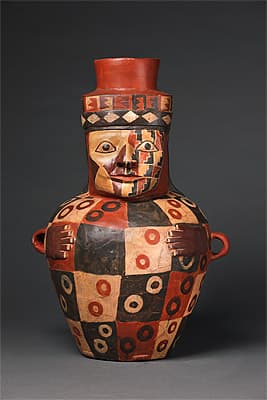
HUARI culture 600 – 1000 AD
Faceneck jar 600-1000 AD ceramic50.3 (h) cm 33.6 cm (diameter) Ministerio de Cultura del Perú: Museo Nacional de Arqueología, Antropología e Historia del Perú, Photograph: Daniel Giannoni
Nazca and Tiahuanaco influence on Huari culture was marked, and can be seen especially in the complex patterning and bright colours employed by their respective artists. Eleven very similar faceneck, or effigy, jars were found together at Pacheco,1 each with painted faces and wearing tie-dyed unkus (tunics) and caps. ‘The jars are known as facenecks because a human visage appears on the neck of the vessel; the human’s body is synonymous with that of the vessel’.2 Facial features and hands are made in relief and the entire vessel is painted with slip. Despite almost identical decorative schema, the face of each warrior is slightly different in modelling and ornament. The checkerboard stepped motif covering most of each face probably had ritual meaning, now obscure, although the pattern has been associated with agricultural terraces.3
Christine Dixon
1. S. K. Lothrop, Treasures of ancient America: Pre-Columbian art from Mexico to Peru, Geneva: Skira, New York: Rizzoli 1979, p. 210. They were among more than three tons (about 2.7 tonnes) of ceramics discovered in 1927 by Julio C. Tello: see Mary Glowacki, ‘Shattered ceramics and offerings’, in Susan E. Bergh et al., Wari: Lords of the ancient Andes, New York: Cleveland Museum of Art and Thames and Hudson 2012, p. 146.
2. Glowacki, p. 145.
3. Federico Kauffmann-Doig, Ancestors of the Incas: The lost civilizations of Peru, Memphis, Tenn.: Lithograph Publishing 1998, p. 92.
Nazca and Tiahuanaco influence on Huari culture was marked, and can be seen especially in the complex patterning and bright colours employed by their respective artists. Eleven very similar faceneck, or effigy, jars were found together at Pacheco,1 each with painted faces and wearing tie-dyed unkus (tunics) and caps. ‘The jars are known as facenecks because a human visage appears on the neck of the vessel; the human’s body is synonymous with that of the vessel’.2 Facial features and hands are made in relief and the entire vessel is painted with slip. Despite almost identical decorative schema, the face of each warrior is slightly different in modelling and ornament. The checkerboard stepped motif covering most of each face probably had ritual meaning, now obscure, although the pattern has been associated with agricultural terraces.3
Christine Dixon
1. S. K. Lothrop, Treasures of ancient America: Pre-Columbian art from Mexico to Peru, Geneva: Skira, New York: Rizzoli 1979, p. 210. They were among more than three tons (about 2.7 tonnes) of ceramics discovered in 1927 by Julio C. Tello: see Mary Glowacki, ‘Shattered ceramics and offerings’, in Susan E. Bergh et al., Wari: Lords of the ancient Andes, New York: Cleveland Museum of Art and Thames and Hudson 2012, p. 146.
2. Glowacki, p. 145.
3. Federico Kauffmann-Doig, Ancestors of the Incas: The lost civilizations of Peru, Memphis, Tenn.: Lithograph Publishing 1998, p. 92.
Nazca and Tiahuanaco influence on Huari culture was marked, and can be seen especially in the complex patterning and bright colours employed by their respective artists. Eleven very similar faceneck, or effigy, jars were found together at Pacheco,1 each with painted faces and wearing tie-dyed unkus (tunics) and caps. ‘The jars are known as facenecks because a human visage appears on the neck of the vessel; the human’s body is synonymous with that of the vessel’.2 Facial features and hands are made in relief and the entire vessel is painted with slip. Despite almost identical decorative schema, the face of each warrior is slightly different in modelling and ornament. The checkerboard stepped motif covering most of each face probably had ritual meaning, now obscure, although the pattern has been associated with agricultural terraces.3
Christine Dixon
1. S. K. Lothrop, Treasures of ancient America: Pre-Columbian art from Mexico to Peru, Geneva: Skira, New York: Rizzoli 1979, p. 210. They were among more than three tons (about 2.7 tonnes) of ceramics discovered in 1927 by Julio C. Tello: see Mary Glowacki, ‘Shattered ceramics and offerings’, in Susan E. Bergh et al., Wari: Lords of the ancient Andes, New York: Cleveland Museum of Art and Thames and Hudson 2012, p. 146.
2. Glowacki, p. 145.
3. Federico Kauffmann-Doig, Ancestors of the Incas: The lost civilizations of Peru, Memphis, Tenn.: Lithograph Publishing 1998, p. 92.

